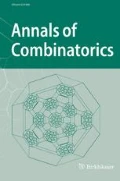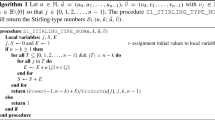Abstract
Let \({\mathcal{S} = (s_1, s_2, \ldots)}\) be any sequence of nonnegative integers and let \({{S_{k} = \sum_{i=1}^k} {s_i}}\).We then define the falling (rising) factorials relative to \({\mathcal{S}}\) by setting \({(x)\downarrow_{k, \mathcal{S}} = (x- S_{1})(x-S_2) \cdots (x-S_k)}\) and \({(x)\uparrow_{k, \mathcal{S}}= (x+S_1)(x+S_{2}) \cdots (x+S_{k})}\) if \({k \geq 1}\) with \({(x)\downarrow_{0,\mathcal{S}}= (x)\uparrow_{0, \mathcal{S}}= 1}\). It follows that \({\{(x)\downarrow_{k,\mathcal{S}}\}_{k > 0}}\) and \({\{(x)\uparrow_{k,\mathcal{S}}\}_{k > 0}}\) are bases for the polynomial ring \({\mathbb{Q}[x]}\). We use a rook theory model due to Miceli and Remmel to give combinatorial interpretations for the connection coefficients between any two of the bases \({\{(x)\downarrow_{k,\mathcal{S}}\}_{k \geq 0}, \{(x)\uparrow_{k,\mathcal{S}}\}_{k \geq 0}, \{(x)\downarrow_{k,\mathcal{T}}\}_{k \geq 0}}\), and \({\{(x)\uparrow_{k, \mathcal{T}}\}_{k \geq 0}}\) for any two sequences of nonnegative integers \({\mathcal{S} =(s_1, s_2, \ldots)}\) and \({\mathcal{T} = (t_1, t_2, \ldots)}\). We also give two different q-analogues of such coefficients. Moreover, we use this rook model to give an alternative combinatorial interpretation of such coefficients in terms of certain pairs of colored permutations and set partitions with restricted insertion patterns.
Similar content being viewed by others
References
Briggs, K.S., Remmel, J.B.: A p, q-analogue of a formula of Frobenius. Electron. J. Combin. 10(1), #R9 (2003)
Briggs, K.S., Remmel, J.B.: m-Rook numbers and a generalization of a formula of Frobenius \({\mathcal{C}_{m} \wr \mathcal{S}_{n}}\) to . J. Combin. Theory Ser. A 113(6), 1138–1171 (2006)
de Médicis A., Leroux P.: A unified combinatorial approach for q- (and p, q−) Stirling numbers. J. Statist. Plann. Inference 34(1), 89–105 (1993)
de Médicis A., Leroux P.: Generalized Stirling numbers, convolution formulae and p, q-analogues. Canad. J. Math. 47(3), 474–499 (1995)
Garsia A.M., Remmel J.B.: Q-counting rook configurations and a formula of Frobenius. J. Combin. Theory Ser. A 41(2), 246–275 (1986)
Goldman, J., Haglund, J.: Generalized rook polynomials. J. Combin. Theory Ser. A 91(1-2), 509–530 (2000)
Gould H.W.: The q-Stirling numbers of first and second kinds. Duke Math. J. 28, 281–289 (1961)
Lindsay J., Mansour T., Shattuck M.: A new combinatorial interpretation of a q-analogue of the Lah numbers. J. Comb. 2(2), 245–264 (2011)
Miceli, B.K.: Two q-analogues of poly-Stirling numbers. J. Integer Seq. 14(9), Art.11.9.6 (2011)
Miceli, B.K., Remmel, B.K.: Augmented rook boards and general product formulas. Electron. J. Combin. 15, #R85 (2008)
Milne S.C.: Restricted growth functions, rank row matchings of partition lattices, and q-Stirling numbers. Adv. Math. 43, 173–196 (1982)
Remmel, J.B., Wachs, M.: Rook theory, generalized Stirling numbers and (p, q)- analogues. Electron. J. Combin. 11, #R84 (2004)
Wachs M.,White D.: p, q-Stirling numbers and set partition statistics. J. Combin. Theory Ser. A 56(1), 27–46 (1991)
Wachs, M.: \({\sigma}\) -Restricted growth functions and p, q-Stirling numbers. J. Combin. Theory Ser. A 68(2), 470–480 (1994)
White D.: Interpolating set partition statistics. J. Combin. Theory Ser. A 68(2), 262–295 (1994)
Author information
Authors and Affiliations
Corresponding author
Additional information
Supported in part by NSF grant DMS 0400507.
Rights and permissions
About this article
Cite this article
Liese, J., Miceli, B.K. & Remmel, J. Connection Coefficients Between Generalized Rising and Falling Factorial Bases. Ann. Comb. 19, 337–361 (2015). https://doi.org/10.1007/s00026-015-0268-7
Received:
Published:
Issue Date:
DOI: https://doi.org/10.1007/s00026-015-0268-7




